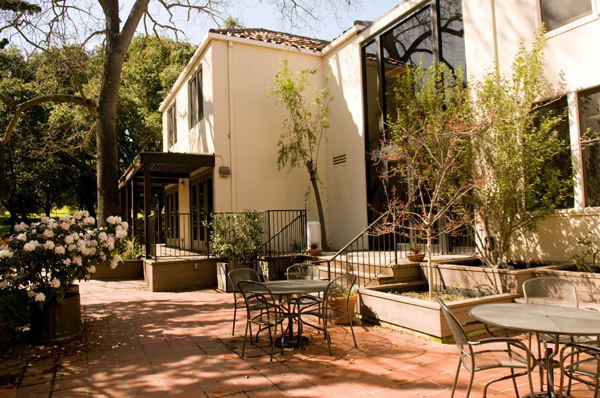“I woke up at 3:30 today,” said Elena Recaldini ’24 from Japan. The catch: Her class starts at 3:30 a.m., not p.m. Her Chinese language course with mandatory participation is held before daybreak.
On Thursdays, she attends class continuously from 3:30 a.m. to 9 a.m. On Tuesdays, Recaldini can catch a break as her earliest class starts at 4:30 a.m.: “I have one hour extra of sleep,” she said.
At hours that college students would typically be asleep, those living many time zones away have adjusted their schedules to attend synchronous courses during an entirely virtual quarter.
Approximately 13% of the undergraduate student body consists of international students. For students living in East Asia, some in areas 17 hours ahead of Stanford, this schedule can be particularly inconvenient. Many undergraduate courses begin at 9 a.m. PT, or 2 a.m. in Japan and South Korea.
Recaldini says she struggles to go back to bed after “staring at a screen for an hour straight.”
“I have a messed up sleep schedule,” Eju Ro ’24 from South Korea wrote in an email to The Daily.
Gayatridevi Kamat Tarcar ’24 from Goa, India — 13.5 hours ahead of California — participates in classes through the night. But the large time zone gap isn’t her only issue. Because she lives in a coastal state with heavy rainfall, her internet connection “went down a couple of times,” she wrote in an email to The Daily.
Coordinating with peers can also be a challenge. To meet with classmates for team projects, Recaldini has had to participate in calls early in the morning. “5 a.m. better than 3 a.m., so I’m not complaining,” she said.
She has also had to take exams in the middle of the night. For CHEM 31M: “Chemical Principles: From Molecules to Solids,” she has taken two exams at 2 a.m.
“We’re all graded the same, so it’s disadvantageous for me,” Recaldini said. She said that other courses have been more accommodating. CS106A: “Programming Methodologies” allowed her to reschedule her exam.
The Center for Teaching and Learning has assembled advice for instructors to “raise awareness of the issue of large time-zone differences,” according to University spokesperson E.J. Miranda. These guidelines include maximizing asynchronous and flexible participation.
Any student may request accommodations that are typically granted “at the discretion of the instructor,” with the exception of students with documented disabilities, Miranda wrote.
CHEM 31M exams are held synchronously so instructors are available to answer students’ questions during the exam period, School of Humanities and Sciences spokesperson Joy Leighton wrote in an email to The Daily.
Unlike domestic students, those living internationally are not able to use chemistry lab kits and conduct hands-on learning. While students in the United States conduct labs synchronously, international students just watch, according to Recaldini.
According to Leighton, box lab kits were not shipped internationally “due to government regulations unique to each country.” Instructors will tell students if they are “able to use everyday materials” instead, Leighton wrote.
Ro said she was “surprised” by how few courses were listed as asynchronous. While it later became apparent that some of the synchronous courses would in fact be offered asynchronously, she explained that it was difficult to select courses that she was both interested in and offered at a reasonable time.
Twice a week, Ro attends FEMGEN 187C: “Evolution of the First Person Feminist Essay” at 2 a.m. While this class has an asynchronous option, she felt that “it wouldn’t be worth taking” if she wasn’t able to participate in live discussions.
Extracurricular activities have been “a little bit hard to keep up,” Ro wrote. However, she’s “glad to see that clubs are trying to help us form communities.”
Kamat Tarcar joined the Stanford Mixed Company, a student a cappella group. She wrote that she is “really happy” to be a member, but acknowledges the difficulty in coordinating meeting times that are convenient for everyone.
Eu Jin Jung ’24, another student from South Korea, said that he’s been “pleasantly surprised.”
Jung has been able to find overlaps in time zones to work with with classmates. He added that he’s found a community in South Korea. With cases largely under control, the government has eased social distancing guidelines.
But Jung has still faced challenges.
“Zoom fatigue is real,” he said, adding that, “meeting new people over Zoom is exhausting.” Stanford students, domestic and international, have expressed concern over Zoom fatigue, citing the adverse effects of staring a screen for hours.
Kamat Tarcar has also found faculty and classmates to be “very accommodating.” She wrote that her professors have allowed her to schedule meetings outside of office hours and she’s found time to work with classmates.
Miranda wrote that the University appreciates international students’ patience and flexibility amid COVID-19 disruptions, and is committed to “develop ways to address their specific academic needs.”
The University is planning to invite frosh, sophomores and new transfer students back to campus next quarter. For frosh living overseas, this would be an opportunity to take courses at reasonable hours with their domestic peers. This plan allows all frosh and sophomores to return during a designated quarter, unlike special-circumstances housing which allows approved students of any year to live on campus.
Recaldini, Jung and Kamat Tarcar were approved for winter quarter special-circumstances housing, so they are planning to go to campus.
“Hopefully I won’t be nocturnal anymore,” Recaldini said.
Ro did not apply for special circumstances housing, but is now “regretting” that decision, she wrote.
Kamat Tarcar wrote that whether or not she will go is “subject to my health, COVID conditions and whether or not I have my visa.” International students struggled to obtain visas this summer amid COVID-19 disruptions.
Daylight savings was in effect at the time of all interviews.
Contact Anna Milstein at annamil ‘at’ stanford.edu.
